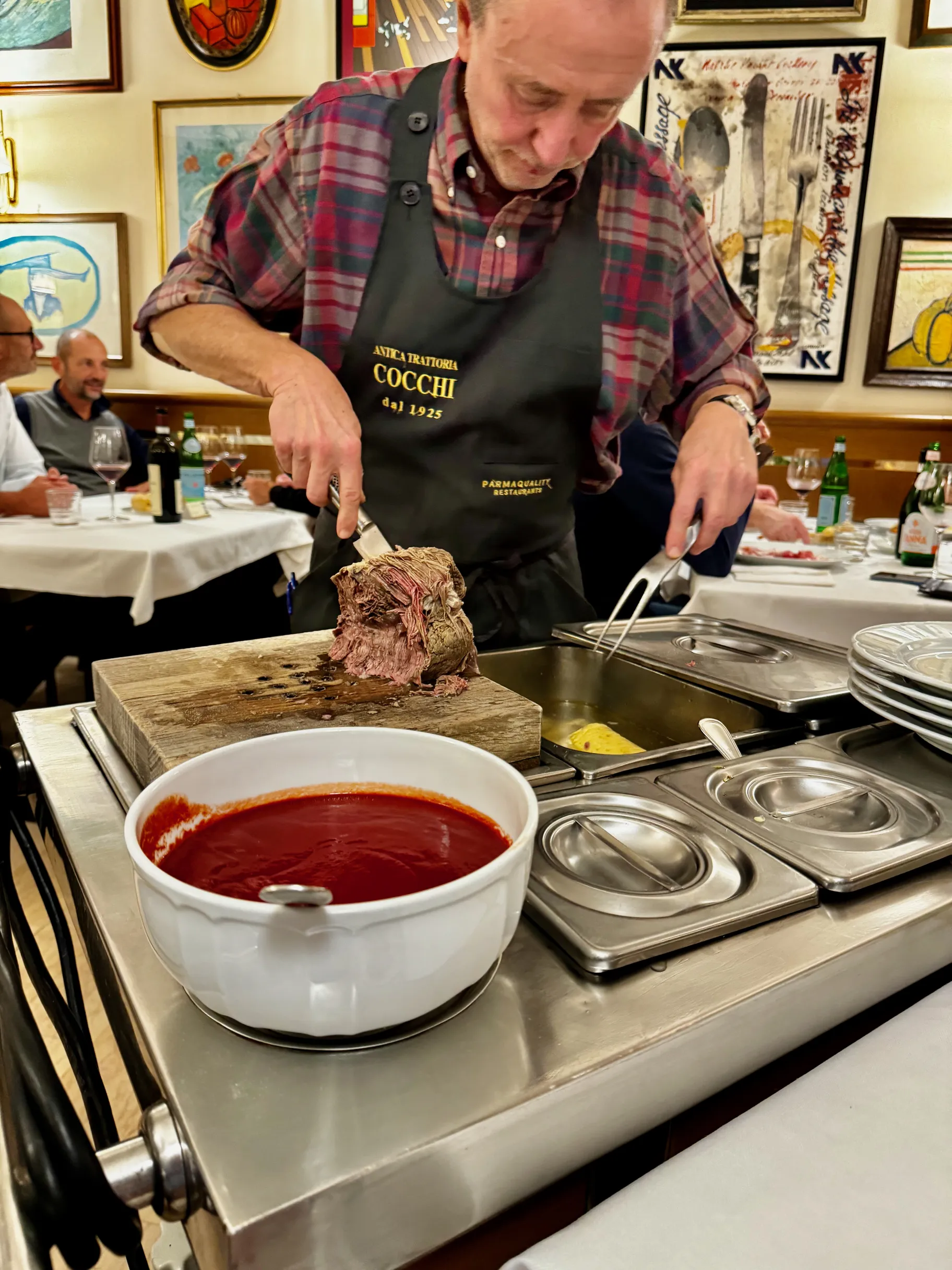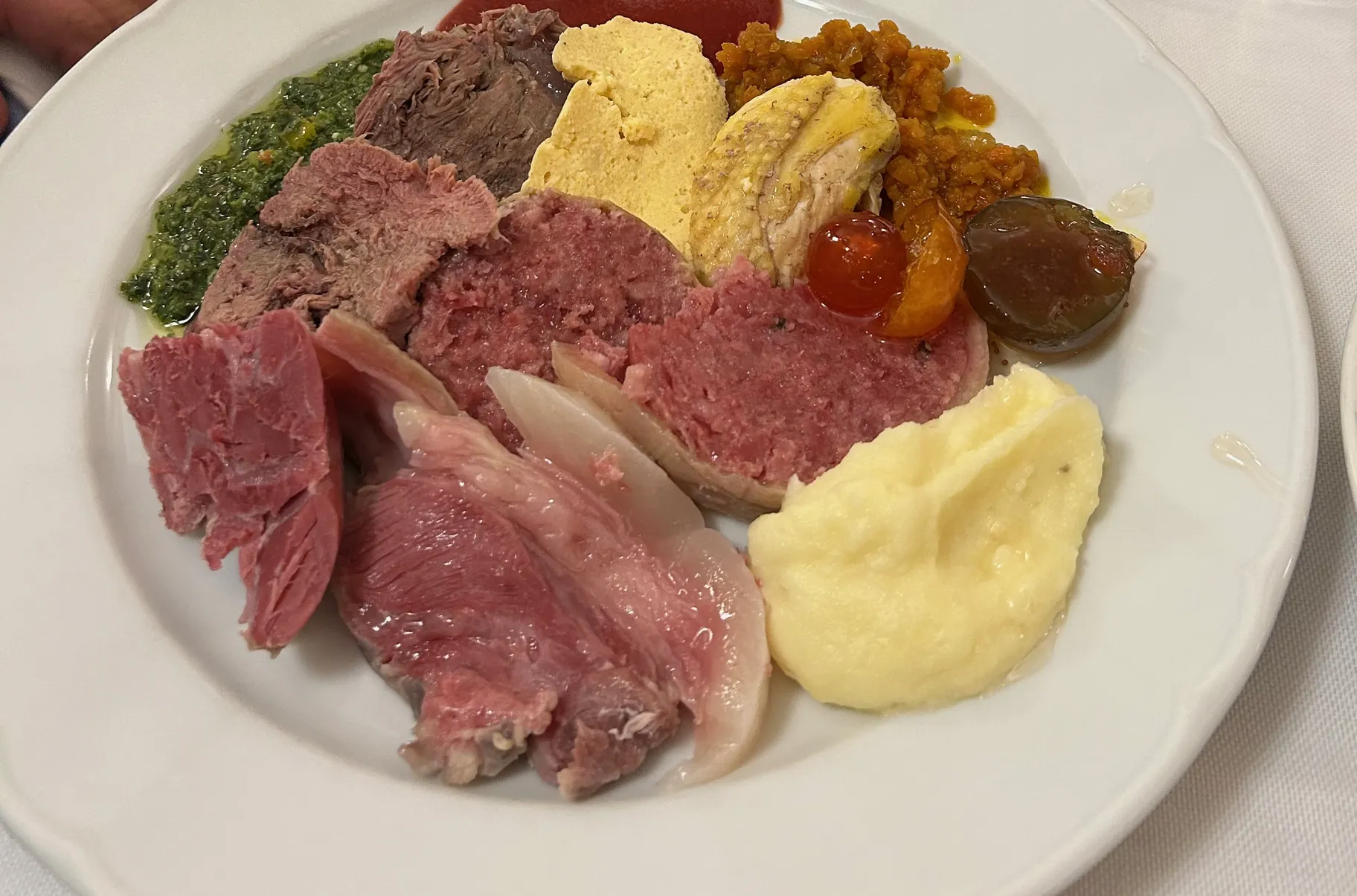When the weather cools, we start to think about soups and stews, but this trip through the Italian region of Emilia Romagna has reminded me of a dish that is the ultimate salute to meaty goodness: the bollito misto or mixed boil. It is a deeper commitment to meat than either New England or New Orleans mixed boils, which have their own appeal. The bollito misto only has vegetables in the pot as aromatics to flavor the meat and the broth, but you can add additional carrots to the broth, as well as potatoes, towards the end of cooking if you feel you must have some veg to accompany the meats. Personally I favor accompanying the meats with a potato purée and finishing with a sharply dressed salad of radicchio and Belgian endive.
A couple of well-flavored and piquant condiments accompany the simply boiled cuts of meat. Most frequently seen is a salsa verde made of parsley, capers, anchovies, garlic, olive oil and lemon juice. Traditionally a grated hard-boiled egg is added for richness and to thicken the sauce. Oftentimes there is also a salsa rossa or red sauce made of peppers, sun-dried tomatoes or tomato paste, garlic, and a bit of bread to thicken it.
Usually boiled meats are a by-product of making stock or soup, but the bollito flips that around, so that the meats are each cooked to their individual doneness. Some cooks choose to cook each cut of meat in its own separate pot. Others will put all the meat together in a large pot and transfer each cut out as it’s done with enough broth to keep the cut moist.

A server at famed Ristorante Cocchi 1925 in Parma serves bollito misto from a specially made cart. Photo by Royce Burke.
The phrase “boiled meats” doesn’t do justice to what one finds in the many compartment carts wheeled around restaurants in Emilia Romagna and the neighboring region of Piemonte. Europeans take certain meals seriously enough to create brotherhoods around them, and bollito misto has two. Think of them as eating clubs where members (nearly all men) wear cloaks and convene to cook, eat, and argue the endless minutiae involved in cooking and eating this deeply cultural dish. Because tradition says there should be seven cuts along with lesser ones and many sauces, this is a dish fully experienced in a restaurant featuring special carts with compartments for each type of meat, broth and condiment. It’s a special occasion to splash out, followed by a long nap.
However, a home-based bollito is easy enough to do, and is strangely enough the perfect make-ahead meal for your carnivore friends. As long as you plan in advance and do some of the work the day before you serve, it is easily doable.

An assortment of boiled meats served with potato puree and condiments at Ristorante Cocchi 1925 in Parma. Photo by Shari Lusskin.
Begin by sourcing your meats. Since this is unadorned meat-eating, buy the meat from a butcher, if possible, who can give you what you need. The key to a great bollito is a mixture of meats with different textures and flavors, so ideally there would be beef oxtail, tongue, short ribs, slices of beef shank, and a rolled boneless chuck roast, brisket, bottom round, rump roast. But don’t feel you need to make all of these. Most people will want the addition of a cotechino, a raw sausage that you can buy frozen that is added to the pot, or a zampone, a pig’s trotter stuffed with sausage that adds unbelievable richness to the broth and overall experience. But again, they are not necessary to the home-based experience.
Essentially you are making a meat broth, but the meat is the star, so you’re cooking it just until it’s done. Not to death. We begin with a large pot filled with water and the aromatics that will flavor both meat and broth, onion, celery, carrot, garlic, cloves, parsley, and rosemary.
For tutorials on how to go about making the feast yourself, here are three. The first is from an LA Times article from 2014 by Irene S. Virbilia. It’s straightforward and her tales of feasting in Italy are lovely. The second is from Serious Eats, where Daniel Gritzer breaks down the whys and how for you. And the third is from wonderful cook David Tanis. But once you go down the rabbit hole of bollito misto, you’ll find there are many tutorials out there with differing recipes for the sauces.
